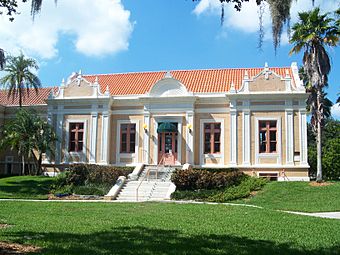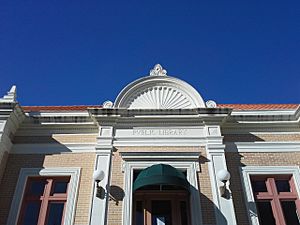Mirror Lake Library facts for kids
Quick facts for kids |
|
|
St. Petersburg Public Library
|
|
 |
|
| Location | St. Petersburg, Florida |
|---|---|
| Architectural style | Beaux-arts |
| NRHP reference No. | 86001259 |
| Added to NRHP | June 13, 1986 |
The St. Petersburg Public Library is also known as the Mirror Lake Community Library or Carnegie Library. It was built in 1915 in a fancy style called Beaux-Arts. This library was one of only 10 Carnegie libraries in Florida that received money from the Carnegie Corporation of New York.
A very rich man named Andrew Carnegie gave money to build over 3,000 libraries in the United States, Canada, and Europe. The St. Petersburg Public Library is important because it was the city's first permanent public library. It shows how St. Petersburg grew from a small town into a city with important cultural places in the early 1900s.
Contents
History of the Library Building
In 1908, leaders in St. Petersburg wanted to build a public library. After five years of hard work, the city received a $17,500 grant in 1913 from the Carnegie Corporation. The city also put in the same amount of money. On July 17, 1914, they chose a spot for the library next to the city's reservoir, which is now called Mirror Lake.
Architectural Style: Beaux-Arts
The Mirror Lake Community Library was built in the Beaux-Arts style. This style uses lots of decorative sculptures and bold, strong shapes. You can see rich, deep edges and fancy designs on the building. The Beaux-Arts style was very popular in American architecture from 1880 to 1920.
The architect who designed this library was Henry D. Whitfield. He worked for the Carnegie Corporation and designed many other Carnegie libraries in this same style.
Fair Access and Community Libraries
When Andrew Carnegie gave money for libraries, he wanted them to be open to everyone. However, when the St. Petersburg library opened in 1915, the city was still segregated by race. This meant that Black residents were not allowed to use the main library.
It wasn't until 1944 that Black residents were allowed into the basement of the Carnegie library. A local pastor's wife, Mrs. S.M. Carter, worked with people of different races to ask the city for money. Because of their efforts, the James W. Johnson Library branch opened. This was the city’s first library specifically for the African American community.
Early Librarians and Supporters
The first librarian at Mirror Lake Library was Miss Emma Moore Williams. Before this, she was the first English teacher at St. Petersburg High School. People described her as a very good and popular teacher. Her assistant was Miss Margaret Jenkins.
Miss Williams' first job as librarian was to organize and put away 3,000 books. These books came from an older reading room on 4th Street. The new library building was designed to hold 16,000 books.
Mrs. Annie McRae was a big supporter of getting a Carnegie library for St. Petersburg. She was offered the librarian job first but turned it down. She felt it would be a conflict of interest because she was the secretary of the library board. Mrs. McRae wrote articles in the St. Petersburg Times to encourage the city to use tax money for more books. She believed libraries were for "information, for recreation, and for inspiration."
Friends of the Library and New Services
In 1946, Miss Hilda Glaser became the Director of the Library. She saw that the library needed improvements. She suggested that the city create a group called the "Friends of the Library." This group started on April 11, 1947. Their goal was to help people use the library more and plan for its growth.
The Friends of the Library could receive gifts and donations for the library. Their first big success was working with the Junior League to get a bookmobile. A bookmobile is like a library on wheels! The city received its first bookmobile in February 1949. This mobile library helped bring books to more people until 1962.
On June 13, 1986, the library was added to the National Register of Historic Places in the U.S.. The Mirror Lake Community Library was the only library in St. Petersburg until the current Main library was built in 1964.
Library Renovations and Updates
By the 1980s, the Mirror Lake Community Library was in bad shape. The air conditioning system was broken, and there was water damage and mold. The second floor was hard to reach, and the main entrance was closed. The city studied the building to see if it could still be used as a library.
Restoration Plans and Challenges
In 1987, the City Council approved a plan to fix the library. A part of the building added in 1951 would be removed. A new section would be built, and the original 1915 building would be restored.
The restoration took longer than expected. They found unexpected damage, and there were disagreements about the city's budget. Finally, on January 18, 1994, then-mayor David Fischer reopened the fixed-up 1915 part of the library. At this time, the elevator was not yet installed, so it was still hard for people with disabilities to access all areas.
Modern Accessibility and Expansion
In 1997, the renovation project was finished. The library was expanded with an 8,000-square-foot addition. This new part was designed to look good with the old building. An elevator was also added, making all levels accessible for everyone. The library, with its new wing, reopened on May 21, 1997.
Programs and Services Offered
The Mirror Lake Community Library is a branch of The St. Petersburg Library System. It is also part of the Pinellas Public Library Cooperative. People who use this library can borrow books, CDs, DVDs, audiobooks, and magazines.
The library also offers many online resources. These include Hoopla Digital, OverDrive, Inc., and Ancestry.com. You can ask for items from other Pinellas County Libraries. You can also request interlibrary loans through the library's website or in person.
Community Events and Learning
The Mirror Lake Community Library has many programs. You can find a calendar of events on their website. Some programs include:
- Weekly story times for younger kids.
- Reading sessions with therapy dogs.
- ESL (English as a Second Language) classes.
- Walk-in computer help.
- Meditation classes.
- Special events sponsored by the Friends of the Library.
Meeting Room Availability
The library has one meeting room that patrons can reserve. You can apply to use the meeting room on the library's website. This room is for non-profit groups. They must be doing activities related to the library, or educational, cultural, intellectual, charitable, or community-related events.





